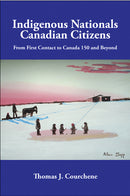Description
Indigenous Nationals, Canadian Citizens: From First Contact to Canada 150 and Beyond by Thomas J. Courchene and published by the Institute of Intergovernmental Relations (Queen’s University), is a view forward favouring regional and culturally focused institutions, rather than nationally focused strategies. This view is based on Courchene’s perspective that Indigenous-state relations are transforming positively. This work is a proposal for a bold political and institutional infrastructure for Canada’s First Nations as a vehicle for future socio-economic improvements. Indigenous Nationals, Canadian Citizens is comprised of six parts: Part 1, an Introduction and Socio-Economic Overview; Part 2, A Voyage to Hell and Back: From First Contact to Sesquicentennial; Chapter 3 Milestones in Canada-Indigenous Relations: From Columbus to the Constitution Act, 1982 including Supplement 3.1: The Iroquois in North America; Part 3, Indigenous Rights and Reconciliation; Part 4, Analytical Perspectives; Part 5, Voyages of Recovery, and a Part 6, a Pathway Forward for Treaty First Nations. Part 4, Analytical Perspectives, is comprised of four substantive chapters devoted to creating a political and institutional framework enabling Canada’s First Peoples to be at the same time Indigenous Nationals and Canadian citizens. The author suggests that this combination will close the socio-economic gap with fellow Canadians. Chapter 7 discusses the analytical backdrop through three previously identified models: Enfranchisement: Canadian Nationals/Canadian Citizens using the Trudeau/Chretien and Flanagan models; Institutionalized Parallelism: Indigenous Nationals/Indigenous Citizens; and, Indigenous Nationals/Canadian Citizens – a Nation-Canadian state relationship. Chapter 8 includes Land Claim agreements that implement the Indigenous nationals/Canadian citizens model. Chapter 10 discusses a Commonwealth of Sovereign Indigenous Nations (CSIN) model loosely based on the Federation of Saskatchewan Indigenous Nations (this Federation’s new name). This chapter outlines prerequisites for First Nations economic viability through the CSIN model by discussing property rights, CSIN-INAC relations, the Indian Act, territorial powers briefly overviewing spending powers, and natural resources powers. This overview of the CSIN includes personal jurisdiction powers, financing, taxation, Education on- and off-reserve, political federalism, urban reserves, an example Whitecap Dakota First Nation, and duelling economic models. Appendices and References are included.


